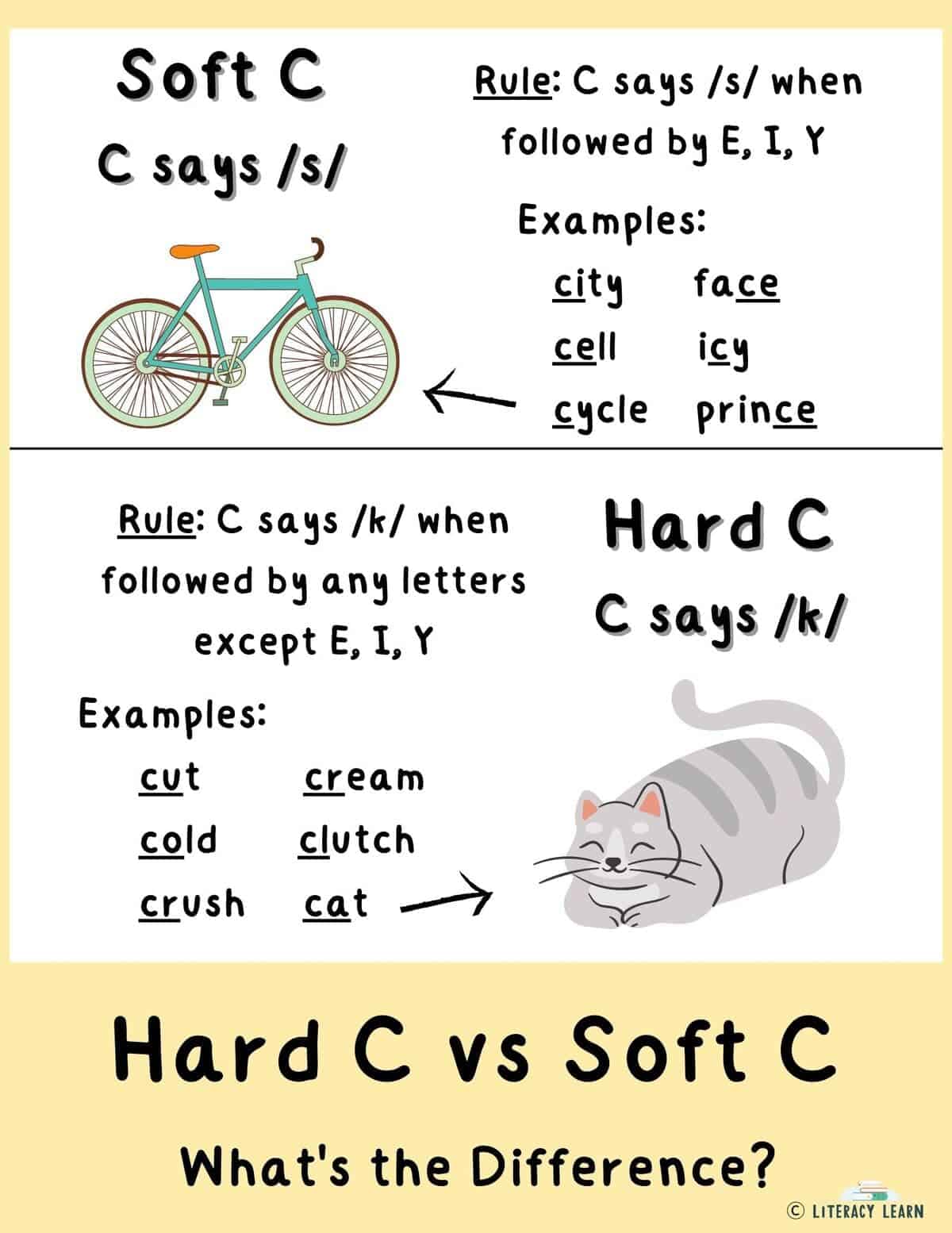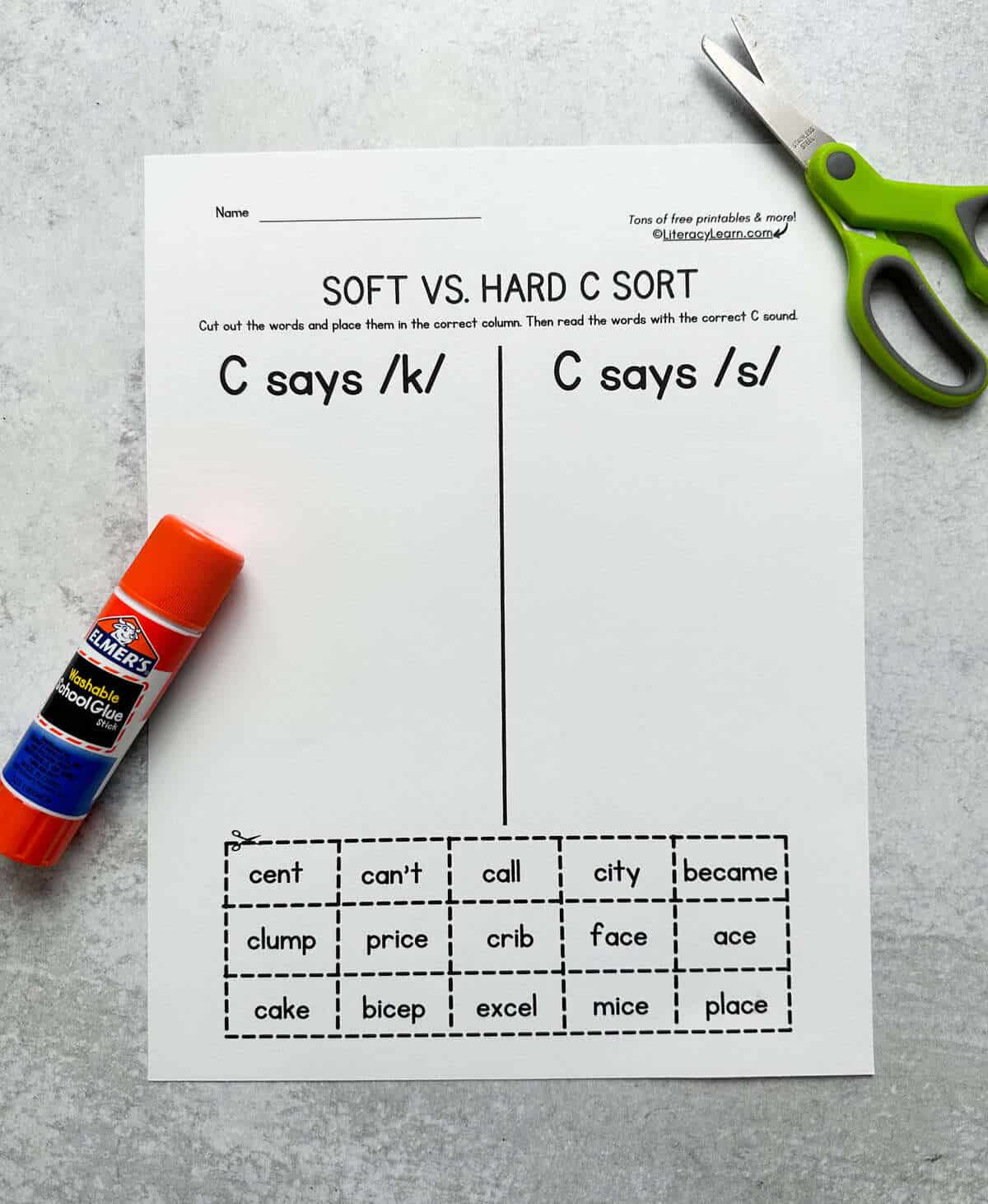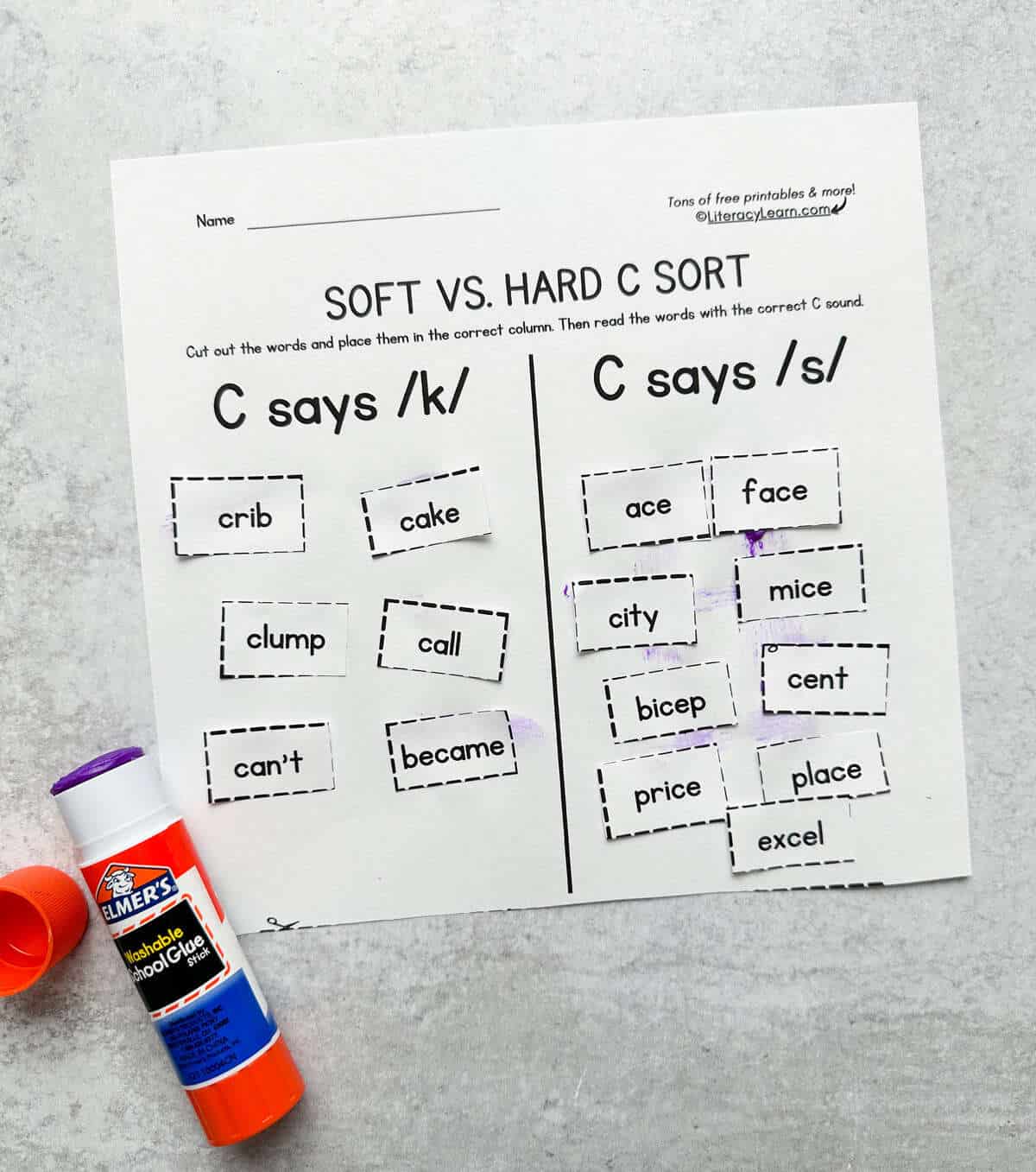All About Hard C and Soft C Words: Free Worksheet
This post may contain affiliate links. As an Amazon affiliate, we earn from qualifying purchases.
Learn the rules for when the letter C says its soft sound, the /s/ sound. Here you’ll get the best tips for teaching soft C to your students, and view the most common soft C words in English. Then grab a FREE word sort for students to practice differentiating between hard C and soft C words.

All About Hard and Soft C
The letter C can make two sounds:
- /k/ like cat
- /s/ like city
👆🏼 The first sound of C, the /k/ sound, is called the hard sound. This is the most common sound, with over 3,900 English words where C represents the /k/ sound, like in the word cat.
✌🏼 The second sound of C, the /s/ sound, is called the soft sound. Over 1,200 words include the soft C sound, like in the word city.
When first introducing the letter C to students in preschool and kindergarten, we teach the hard sound of C.
Many reading programs use the letter, a keyword, and a sound, like we do in our alphabet anchor chart. For the visual part of your lesson, you might hold up a flashcard of the letter C and kids repeat: “C – cat – /k/.
But by the time children are in the middle of first grade, they’ll need to learn that C can also make the /s/ sound. Most scope and sequences introduce this concept after kids have mastered short vowels, digraphs, consonant blends, and VCe words.
Soft C Rule
We don’t need to teach a hard C rule, because children should firmly know that C says /k/. We only introduce the rule for teaching the second sound of C, the soft sound, because now kids need to know that C can make two sounds.
Thankfully, there is a general rule that will help us know when C will say /s/.
👉 Rule: When the letter C is followed by the letter E, I, or Y, it will usually say its soft sound /s/.
Teach your students that they need to look just past the letter C at the letter that follows the C. If the next letter is an E, I, or Y, it will say /s/.

Soft C Words
Below are the most frequent Soft C words in English.
Soft C Word Examples
- place
- face
- city
- since
- voice
- decide
- space
- certain
- ice
- piece
- nice
- center
- sentence
- surface
- except
- chance
- notice
- cell
- force
- office
- police
- dance
- race
- circle
- twice
- fence
- produce
- prince
- France
- bicycle
- cyst
- silence
- mercy
- fancy
- emergency
Notice in all of these words, the letter C is followed by an E, I, or Y. That’s why the C makes the /s/ sound in these words.
You might also notice that many words happen to end in the letters -ce. This includes words like fence, France, police, face, and chance. Students will likely automatically assume that since the word ends in E, it’s going to be a Magic E.
That is NOT the case. Be sure to teach that another important job of the E is that is makes C say it’s soft sound. That is the job of the E in all of these words.
If you’re looking for more words list, grab our Ultimate Phonics Word List with over 2000+ words, organized by skill and syllable type. Included are word lists and matching Google Slides with more Soft C words.

👨🏽🏫 Teaching Tips
Before teaching this rule, students should know the C vs. K rule (also known as Cat-Kite rule).
What’s great about the Soft C sound is that the same rule is also applied to the Soft G sound. Many programs refer to the Soft C and G rule as the Gentle Cindy Rule.
My #1 teaching tip for teaching Soft C is using Gentle Cindy. It is the BEST way to make phonics instruction FUN and memorable. Believe me – you won’t want to miss out on this amazing teaching tip and free anchor chart resource!
In addition to using Gentle Cindy to introduce the rule, be sure that your students have firm command of the first sound of C – /k/. We never want to introduce a new sound until kids have mastered the previous sound.
Once you’ve explicitly taught the soft C rule, remember to add the grapheme C under the /s/ sound on your sound wall.

📃 Soft C Worksheet
In order to help students learn and practice the Soft C rule, we’ve created a Soft C Word Sort Worksheet.
We love it because it forces kids to look at the letter that follows the C. If it’s an E, I, or Y, then kids will read it with the soft C sound – /s/. If it’s any other letter, the C will say it’s hard sound – /k/.
Get the highlighter ready! Students should highlight the letter C and whatever letter follows it. This will force their eyes to look there.
Then, referencing their Gentle Cindy anchor chart, kids can definitively decide which sound the C will make and decode the word accurately.
Finally, children read the words, then cut, sort, and glue them in the correct column.
We hope you learned a lot about the Soft C rule in this post! Now be sure to print the freebie below and have your students begin practicing the soft sound of C.

🖨 Download & Print
We’d love to hear about your experience using this resource!
Please leave a comment below or tag us on Instagram @literacylearn!
DOWNLOAD TERMS: All of our resources and printables are designed for personal use only in homes and classrooms. Each teacher must download his or her own copy. You may not: Save our files to a shared drive, reproduce our resources on the web, or make photocopies for anyone besides your own students. To share with others, please use the social share links provided or distribute the link to the blog post so others can download their own copies. Your support in this allows us to keep making free resources for everyone! Please see our Creative Credits page for information about the licensed clipart we use. If you have any questions or concerns regarding our terms, please email us. Thank you!


I love this website. Your printables are relevant and necessary to use when teach vocabulary, digraphs, consonant blends, etc. I am always looking forward to downloading your resources to engage my students.
Hi Agnes,
Thank you so much for your kind words. We’re so happy you keep coming back for more resources!
-Katie and Laura
HEY
SO USEFUL and informative, Thank you team.
love
Neha
Hi Neha,
Thanks for the kind comment. We’re so glad you found the information useful and informative.
Katie and Laura
I just found this site and am looking forward to using it and the worksheets/anchor charts. Thank you so much!
Hi Judy,
We are so happy you found us! We love getting feedback like this. Be sure to subscribe so all the new freebies hit your inbox weekly.
Katie and Laura